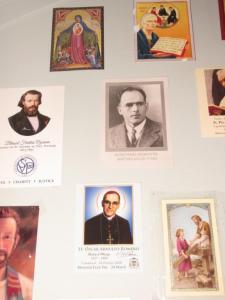Tom Wolfe’s classic essay The “Me” Decade remains a hilarious and insightful look into our oldest religious temptation: that inside our soul exists a divine spark, hidden and asleep, cast aside by the ravages of superficiality. But there are those who help us find the inner spark and thus unite our being with….something. And then, finally, the discovery of the order that actually runs the world! And what an interesting subject undergoing this process: ME!
As Max Weber and Joachim Wach have illustrated in detail, every major modern religion, as well as countless long-gone minor ones, has originated not with a theology or a set of values or a social goal or even a vague hope of a life hereafter. They have all originated, instead, with a small circle of people who have shared some over-whelming ecstasy or seizure, a “vision,” a “trance,” a hallucination—an actual neurological event, in fact, a dramatic change in metabolism, something that has seemed to light up the entire central nervous system. The Mohammedan movement (Islam) originated in hallucinations, apparently the result of fasting, meditation, and isolation in the darkness of caves, which can induce sensory deprivation. Some of the same practices were common with many types of Buddhists. The early Hindus and Zoroastrians seem to have been animated by a hallucinogenic drug known as soma in India and haoma in Persia. The origins of Christianity are replete with “visions.” The early Christians used wine for ecstatic purposes, to the point where the Apostle Paul (whose conversion on the road to Damascus began with a “vision”) complained that it was degenerating into sheer drunkenness at the services. These great drafts of wine survive in minute quantities in the ritual of Communion. The Bacchic orders, the Sufi, Voodooists, Shakers, and many others used feasts (the bacchanals), ecstatic dancing (“the whirling dervishes”), and other forms of frenzy to achieve the kairos . . . the moment . . . here and now! . . . the feeling! . . . In every case the believers took the feeling of ecstasy to be the sensation of the light of God flooding into their souls. They felt like vessels of the Divine, of the All-in-One. Only afterward did they try to interpret the experience in the form of theologies, earthly reforms, moral codes, liturgies.
Nor have these been merely the strange practices of the Orient and the Middle East. Every major religious wave that has developed in America has started out the same way: with a flood of ecstatic experiences. The First Great Awakening, as it is known to historians, came in the 1740s and was led by preachers of “the New Light” such as Jonathan Edwards, Gilbert Tennent, and George Whitefield. They and their followers were known as “enthusiasts” and “come-outers,” terms of derision that referred to the frenzied, holy-rolling, pentecostal shout tempo of their services and to their visions, trances, shrieks, and agonies, which are preserved in great Rabelaisian detail in the writings of their detractors.
The Second Great Awakening came in the period from 1825 to 1850 and took the form of a still wilder hoe-down camp-meeting revivalism, of ceremonies in which people barked, bayed, fell down in fits and swoons, rolled on the ground, talked in tongues, and even added a touch of orgy. The Second Awakening originated in western New York State, where so many evangelical movements caught fire it became known as “the Burned-Over District.” Many new seets, such as Oneida and the Shakers, were involved. But so were older ones, such as the evangelical Baptists. The fervor spread throughout the American frontier (and elsewhere) before the Civil War. The most famous sect of the Second Great Awakening was the Mormon movement, founded by a 24-year-old. Joseph Smith, and a small group of youthful comrades. This bunch was regarded as wilder, crazier, more obscene, more of a threat, than the entire lot of hippie communes of the 1960s put together. Smith was shot to death by a lynch mob in Carthage, Illinois, in 1844, which was why the Mormons, now with Brigham Young at the helm, emigrated to Utah. A sect, incidentally, is a religion with no political power. Once the Mormons settled, built, and ruled Utah, Mormonism became a religion sure enough . . . and eventually wound down to the slow, firm beat of respectability. . . .
What sets Catholicism apart, I think, is the Person of Christ present in the Sacraments – a grounded, physical reality of divine grace. This disencourages a focus on the therapy of self.












